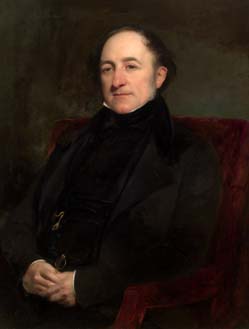 Geologist and science writer Nina Morgan discovers how an underdog came out on top
Geologist and science writer Nina Morgan discovers how an underdog came out on top
It’s a well known axiom: the more accurate the topographic base map, the more accurate and informative the geological map. But it wasn’t until the first topographical maps of England prepared by the Ordnance Trigonometrical Survey – forerunner of the modern Ordnance Survey – became available, that detailed geological mapping in the modern sense became possible.
Among the first geologists to make use of the newly available topographical maps for geological mapping – and the first to geologically colour the whole extent of an Ordnance survey one-inch sheet – was Henry De la Beche (1796-1855). This achievement led to the establishment of what is now the British Geological Survey (BGS) and provided De la Beche with what proved to be a job for life. He served as its first Director-General, holding the post until his death in 1855.
Initially De la Beche began his geological mapping by colouring the new topographic maps of Devon. Initially he used his own money to fund the project. But when his circumstances changed he applied to the Ordnance authorities and in 1832 received a grant of £300 to enable him to complete his map of Devon. The request was granted and he became a ‘Geologist to the Trigonometrical Survey of Great Britain. But then things became acrimonious. His mapping turned up some unexpected fossils that led to a bitter controversy about the age of the rocks. Feelings ran high among the ‘gentleman geologists’ of the Geological Society, with one prominent member, Roderick Murchison (1792-1871), writing that: “De la Beche is a dirty dog… I knew him to be a thorough jobber & a great intriguer & we have proved him to be thoroughly incompetent to carry on the survey.” The dispute went unresolved until the 1840s after further studies were carried out by another geologist, William Lonsdale and by Murchison himself. The result was the establishment of a ‘new’ geological System – the Devonian.
De la Beche was so distressed by attacks like these from people he considered to be his ‘personal enemies’ that he threatened to resign. But in spite of the opprobrium, he was persuaded to continue. After the Devon map was completed in May 1835 things began to look up. De la Beche was asked to carry out a geological survey of Cornwall – and the Geological Survey of Great Britain was born. Even Murchison seems to have eventually changed his mind about De la Beche. In his Life of Sir Roderick I. Murchison, Murchison’s biographer, Archibald Geikie, writes of him: “To the tact of that sagacious man the Survey owed its existence, and to his energy and skill it is indebted for its present importance and the great work for which it has so far accomplished.”
The BGS remains the oldest continuously functioning geological survey in the world. Which just goes to show that dirty or otherwise, every dog has his day!
Acknowledgments
Sources for this vignette include: Life of Sir Roderick I. Murchison Based on his journals and letters with notices of his scientific contemporaries and a sketch of the rise and growth of Palaeozoic Geology in Britain by Archibald Geikie, John Murray, 1875; David Bate, 2010, Sir Henry Thomas De la Beche and the Founding of the British Geological Survey, Mercian Geologist, vol. 17 (3), pp. 149-165 [available for download from:
http://nora.nerc.ac.uk/11264]; Paul J. McCartney, Henry de la Beche: observations on an observer, Friends of the National Museum of Wales, Cardiff, 1977, pp. 77; John Flett, The first hundred years of the Geological Survey of Great Britain, HMSO, 1937, pp. 280; J A Secord, Dictionary of National Biography entry for Sir Henry Thomas De la Beche.
If the past is the key to your present interests, why not join the History of Geology Group (HOGG). For more information and to read the latest HOGG Newsletter visit the new HOGG website at:
www.historyofgeologygroup.co.uk where you’ll also find abstracts for the talks and posters presented at the Conference on Geological Collectors and Collecting, April 2010 available free to download as a pdf, as well as information about how to sign up for a visit to the Geological Society on 31 May 2013 to view early British and European geological maps.
*Nina Morgan is a geologist and science writer based near Oxford.